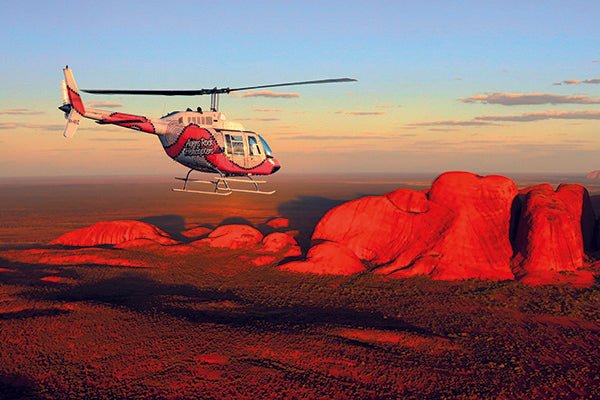Uluru-Kata Tjuta National Park

One of the world’s Seven Natural Wonders rises up abruptly in the heart of the Australian desert, captivating millions of visitors from all over the globe every year. Uluru is one of our country’s icons and rightly so – to stand in front of this giant monolith is to come face to face with nature’s power and majesty.
A lot has changed since tourists first flocked to this famous rock, eager to camp next to it and climb to the top. As Uluru is now recognised as a sacred Aboriginal site, climbing the rock is discouraged and all tourist accommodation has been moved to the township of Yulara, 15km from the rock. Here, you’ll find everything you could possibly need for a stay, long or short.
CAMPGROUND
We opted to take advantage of the special rates Ayers Rock Campground has in place: stay for four nights but pay for three. There’s a lot to see and experience, so any less wouldn’t do justice to the place.
The campground provides powered and unpowered sites for all types of rigs. Facilities include showers, toilets, camp kitchen, playground, laundry and a swimming pool. It is located just 15 minutes’ walk from the IGA supermarket, post office and souvenir shops. If you fancy going out for a meal, there are plenty of restaurants to choose from, though you might find it fairly pricey.
DREAMTIME CONNECTION
For the last 30 years, the Anangu people have managed the park together with Parks Australia. They have chosen to share some of their Tjukurpa, or Dreamtime, stories through the Cultural Centre to give visitors greater insight into their traditional law and culture. The Anangu people designed the free form structure of the Cultural Centre, which is built from locally-made mud bricks, resembling the two ancestral snakes Kuniya and Liru - the stories of these two ancestral snakes give meaning to the south side of Uluru.
HIKE INSTEAD OF CLIMB
Some people travel to Uluru hoping to complete the 1km steep climb to the top of the rock. While the climb is not prohibited, traditional owners ask you to respect their culture by not climbing Uluru. The climb is still open, in favourable weather, but the traditional owners are working towards closing it permanently, due to cultural, environmental and visitor safety issues. More than 35 people have died while attempting to climb Uluru over the years and many others have been injured.
The best way to enjoy and experience Uluru is to hike around the base, which is a 10km walk which takes about 3.5 hours. If you prefer shorter walks, there’s a choice of the 2km return Mala Walk, the 1km return Kuniya Walk and the 4km return Liru Walk.
The Mala Walk provides great insight into the beliefs and values of the Mala people who once lived here and are celebrated through the unique stories that connect them to this sacred site. The peaceful Kantju Gorge awaits at the end of the walk, a place of tranquillity and natural beauty.
The 1km Kuniya Walk is an easy stroll to the picturesque Mutitjulu waterhole, home of the Wanampi, an ancestral watersnake.
Whether you head to Uluru-Kata Tjuta NP for a whirlwind tour or a longer stay, this natural wonder of the world is sure to mesmerise you with its dramatic landscapes and cultural significance.
Getting there
Uluru-Kata Tjuta NP is situated 440km south-west of Alice Springs along sealed roads.
The nearest township is Yulara, 15km to the north
Activities
- Walk or cycle around Uluru
- Valley of the Winds walk
- Visiting the Cultural Centre
- Camel rides
- Helicopter tours







